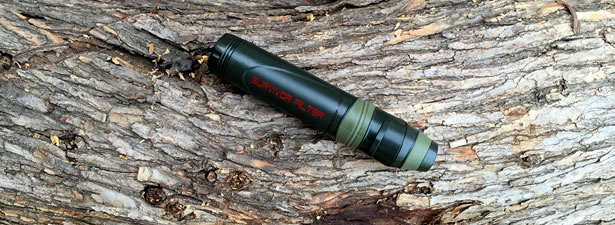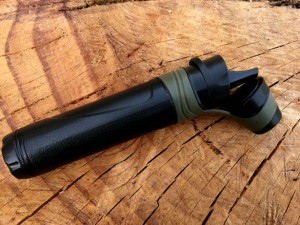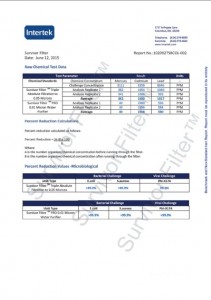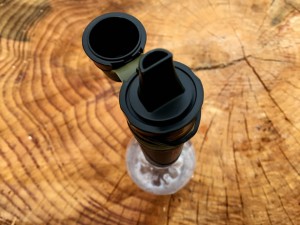Survivor Filter Personal Water Filter Reviewed

Marketing from Survivor Filter
The SURVIVOR FILTER Personal Water Filter system cleans water down to a filtration level of 0.05 microns, the highest level available on the market today, thanks to its TRIPLE FILTRATION (UF Filter (Medical Grade), Carbon Filter, and Mesh Filters). 400% Better Filtration at 0.05 Microns than the Lifestraw at 0.20 Microns. Chemical Free, it replaces 1000 plastic water bottles (264 Gallons) then Filters can be Cleaned or Replaced with Ease. Durable but Weighs Only 3.5 Ounces and Attaches Securely to many Hydration Systems Without Leaking. Ideal for your Bug-out Survival Bag, Emergency Preparedness, Travelling, Camping and Fishing!
Manufacturer: Survivor Filter, survivorfilter.com
Model: Survivor FilterHousing Material: BPA-free ABS
Filter Material: Triple Filtration to 0.05 microns, UF Filtration, Carbon Filtration and Mesh
Flow Rate: 6.76 oz. (200 ml) per minute
Removes: Bacteria, Protozoa, E. Coli, Giardia, Vibrio Cholerae, Salmonella Typhi
Cartridge Life: up to 264 gallons (1000 L)
Dimensions: 1.25″ dia x 7″ (35 mm dia x 180 mm)
Weight: 3.1 ozOrigin: MADE IN THE U.S.A.
UPC: 784672301923
MSRP: $29.99
The Review
When it comes to emergency preparedness for survival in both outdoor and urban environments, one of the most important things to consider is hydration. Clean potable water is vital to our survival, but it is not always available in an emergency situation. We may need to look to unsafe sources for that water. Today, I’ll be looking at the Survivor Filter personal water filter to see how well it can fill that need…
 Survival in an urban environment suffering from a grid-down situation like an earthquake, hurricane or tornado, etc., water will not be readily available from the same convenient sources that we often take for granted like a kitchen faucet or a grocery store shelf. This means that we may need to look for other water sources in our homes that may or may not contain clean potable water in them. Maybe you’ll get lucky and find some water left in a water heater or storage tank, but that would only last so long.
Survival in an urban environment suffering from a grid-down situation like an earthquake, hurricane or tornado, etc., water will not be readily available from the same convenient sources that we often take for granted like a kitchen faucet or a grocery store shelf. This means that we may need to look for other water sources in our homes that may or may not contain clean potable water in them. Maybe you’ll get lucky and find some water left in a water heater or storage tank, but that would only last so long.
Eventually, we would have to look to alternative sources of water like a nearby pool, spa, reservoir, or even from a local drainage ditch. In the wild, water sources are a little more obvious. Creeks, lakes, ponds, rivers, and streams will always be the go-to outdoor water sources. However, water from any of these sources will certainly need to be purified, or at least filtered in some way rendering it safe to drink. Not doing so is an extremely risky thing to do.
I can’t think of many things much worse than being stuck in a survival situation sick with a severe case of diarrhea, vomiting, dehydration, lack of appetite, organ damage, or even death caused by dangerous waterborne pathogens when it is entirely preventable just by properly treating the water before you drink.
Boiling it will always be the best way to purify it, but that is certainly not a viable option in every scenario. Thankfully, there have been numerous manufacturing and technological breakthroughs over the years providing new methods of creating clean potable water that were not available in the past.
Many packable filter options will reduce turbidity and remove particulates all the way down to 0.2 microns eliminating most waterborne bacteria including salmonella, cholera and E.coli, and waterborne protozoa including giardia and cryptosporidium. For most lakes, ponds, rivers and streams here in North America, that is probably all of the filtration that you would ever need. But some personal water filters have gone a step further by filtering particulates all the way down to 0.1 microns thus removing even more bacteria and protozoa.
The Survivor Filter personal water filter has taken water filtration to whole other level by removing impurities and particulates all the way down to .05 microns with their three-stage filtration process that not only removes most bacteria and protozoa, it also removes some viruses and many other contaminants like chlorine and some heavy metals with the use of an integrated carbon filter. This is a feature that most personal water filters do not have.
 Literature available on the Survivor Filter website documents that Intertek Labs located in Columbus, Ohio has tested and certified that the Survivor Filter and Survivor Filter PRO filtration units have been proven to remove 99.9% of E.Coli, Staphylococcus aureus and Phi-X174 from water.
Literature available on the Survivor Filter website documents that Intertek Labs located in Columbus, Ohio has tested and certified that the Survivor Filter and Survivor Filter PRO filtration units have been proven to remove 99.9% of E.Coli, Staphylococcus aureus and Phi-X174 from water.
The body of the Survivor Filter is made from a rugged BPA-free ABS (Acrylonitrile-Butadiene-Styrene) plastic for its light weight and extreme durability. The filter is 7″ long, 1.25″ in diameter and weighs only 3.1 ounces completely dry. On one end there is a cap that protects the mouthpiece tethered with a soft molded rubber lanyard that helps keep the lid attached when it is open and being used. This is a really nice feature because removable lids tend to get lost at the most inopportune moment. Additionally, there is a loop for attaching a lanyard on the same end as the cap.
The Survivor Filter has a no-hassle 30-day money back guarantee, and a limited lifetime warranty. If your Survivor Filter begins to show any manufacturing defect not caused by normal wear and tear, contact them directly for an immediate resolution.
There are three options available for drawing water into the filter unit. The first, and most obvious method is to simply place the water inlet directly into the water source and begin sucking on the mouthpiece to draw the water through the filter. The drawback to this is that you must get very close to the water source which may or may not be easy to do without getting wet.
The second method is to utilize the female threads located on the end of the filter body which easily connect to any standard 28mm threaded plastic bottles, including most collapsible bottles that store flat when empty and thick-walled higher-end plastic water bottles in addition to soda bottles. As a result, it is important to note that the 28mm connector is not compatible with any of the 24mm threaded plastic bottles which tend to be the thinner-walled water bottles.
The third, and final option is to connect a 1/4″ ID food-grade plastic or vinyl tubing to the water inlet nipple located on the end of the filter body. The obvious advantage to this method it that you do not need to get as close to the water source to draw it into the filter unit. Additionally, you can add a pre-filter to the end of the tube or use it to connect the Survivor Filter to a hydration bag.
The three-stage water filtration process consists of a sediment pre-filter, a hollow-tube membrane ultra filter and an activated carbon filter.
Stage 1: Sediment Pre-filter
A thin mesh filter disk located just inside the water inlet is used to prevent sediment and large particulates from entering the filter unit and prematurely clogging up the Ultra Filter. The filter disks can be washed to make them last longer, but the Survivor Filter does come with four replacement disks that will last you a while.
Stage 2: Membrane Ultra Filter
The Ultra Filter (UF) consists of a medical-grade fiber membrane which is essentially hundreds of small porous hollow tubes that looks a lot like thin spaghetti noodles that are about 6″ long. This membrane acts like a barrier, effectively polishing the water by preventing waterborne impurities and particulates 0.05 microns or larger from passing through it. This includes most bacteria, protozoa, and some viruses.
The UF module is designed to process up to 264 gallons, though it can be back-flushed as necessary by flushing clean water in the reverse direction to clear the pores of the membrane. Hollow fiber membranes can work at various temperatures, though the filter membrane can become damaged if left to freeze.
If the water source is particularly dirty or contaminated however, replacing them more frequently may be necessary to keep your Survivor Filter working optimally. UF replacement filters are readily available directly from the Survivor Filter website, and can also be found on Amazon for around $11.95 each.
Stage 3: Activated Carbon Filter
The third and final stage of the filtration process consists of passing water through an Activated Carbon (AC) filter before exiting the filter through the integrated mouthpiece. The granular activated carbon is made from burnt coconut shells having a highly porous surface area which has the natural ability to attract and absorb chemicals, heavy metals and other impurities from water. As the water passes over the surface of the carbon, contaminants are drawn into the pores where they become trapped resulting in clean, odor-free drinking water.
For best results, the activated carbon filter module should be replaced every 264 gallons under normal conditions. This should last one person about 6 months with everyday use. Replacement activated carbon filters with the integrated mouthpiece are available directly from the Survivor Filter website, and can also be found on Amazon for around $9.95 each.
Cleaning and Storage
When the Survivor Filter is working optimally, it can filter as much as 6.76 ounces of water per minute. But when the flow begins to slow to the point of being difficult to draw water from, it is time to backflush the UF filter and clean the debris from the mesh filter disk. This is done by sending clean freshwater in the reverse direction to flush out the pores of the fiber membrane and rinsing off the filter disk as per the directions found in the manual.
 NEVER use commercial cleaning solutions or chemical products to clean the Survivor Filter to prevent any undue damage to the filter and media. The Ultra Filter can be soaked in vinegar for 20 minutes to disinfect it, but not the activated carbon filter. Simply rinsing and drying the activated carbon filter is all that is necessary.
NEVER use commercial cleaning solutions or chemical products to clean the Survivor Filter to prevent any undue damage to the filter and media. The Ultra Filter can be soaked in vinegar for 20 minutes to disinfect it, but not the activated carbon filter. Simply rinsing and drying the activated carbon filter is all that is necessary.
After each use, it is always a good idea to blow out any remaining water that might still be inside the filter unit, and be sure to let it air dry thoroughly before putting it away to prevent mildew, especially for long-term storage.
One clear advantage of the Survivor Filter is that the filter modules are easily replaceable. Filter units and the replacement modules can be stored indefinitely in a clean and dry place, just keep them sealed in their original packaging until they are needed. Additionally, it is best not to store them in direct sunlight, and keep them away from excessive heat sources whenever possible. A small horde of filter modules can effectively turn a Survivor Filter into a long-term water filtration solution at a fraction of the cost of other personal filters without replaceable filter media.
Functional Testing
Living near the coast in Southern California, there are not very many freshwater sources that are not directly attached to a stormwater collection system in some way so there could be all kinds of biohazardous waste, chemicals, insecticides and other dangerous materials in the water. If I was on an outing near a real woodland stream I would not hesitate to give the filter a try, just not in my neck of the woods.
Some may ask why I choose not to recreate some of these crazier tests that some do like drinking urine or toilet water from the bowl. The answer to that question is simple really… I prefer to perform safer and simpler tests that will measurably demonstrate a filter’s ability to remove chemicals and microscopic particulates. In order to perform a series of viable tests, you must first test the water prior to filtering, and then again after filtering followed by documenting the difference. This is the only way to obtain measurable results of any test short of having a laboratory involved in the process.
It is not that I do not trust a manufacturer’s claims, I simply prefer to err on the side of caution while I am ratifying them. Especially when it comes to health and safety risks in a non-emergency situation. I figure that if a filter can remove most of the coloring from a drink like Gatorade, then it is a pretty good filter. If it can also remove most of the sugary taste as well, then it is a great filter. If it can remove all of the color and taste, then it is an exceptional filter.
 Operating the Survivor Filter is as easy as sticking one end directly into a water source or screwing on a 28mm bottle, flipping the endcap open, then drawing water through the mouthpiece from the other end of the filter.
Operating the Survivor Filter is as easy as sticking one end directly into a water source or screwing on a 28mm bottle, flipping the endcap open, then drawing water through the mouthpiece from the other end of the filter.
As most reviewers do when they first get a water filter in the mail, I used it to drink some of my bad tasting city tap water that has a heavy chlorine taste and smell. The filter definitely removed most of the chlorine and other chemicals because the water tasted and smelled much better than normal. Not fancy spring water better, but better nonetheless.
The next test that I performed tested the performance of the Survivor Filter filtering Gatorade. That was a mouthful I know. The filter was able to remove approximately 65% of the coloring and 35% of the sugary flavor. So based on these results in addition to the certification provided by the independent North American laboratory, I am fairly confident that the Survivor Filter can render freshwater from most local waterways and bodies of water safe to drink, but probably not urine or water from a toilet bowl.
For the final test, I tested the Survivor Filter with some pool water. I knew that the excessive chlorine would render the water free of most pathogens, but for this test I was more interested in how well the activated carbon would remove the chlorine and other chemicals improving the overall taste of the water.
After scooping up a bottle full of pool water, I tasted it before attaching the bottle to the filter just to provide a good measurable comparison. With the bottle attached, I drew a few mouthfuls and was pleasantly surprised with the result. The unfiltered swig had a strong chlorine taste, whereas the filtered swig felt clearer in my mouth and only had a very slight chlorine taste. Even better tasting than my city tap water directly from the faucet.
Final Thoughts
The Survivor Filter is an effective personal water filtration device perfect for most urban and outdoor activities and survival situations. Its compact, lightweight and rugged design, ease of use and superior filtration capabilities make it an exceptional choice to consider for backpackers, campers, preppers, survivalists and global travelers alike.
The filter is shaped much like a straw that allows you to drink directly from any freshwater source, or it can be attached to most 28mm bottles for hydrating on the go. However, I would like to see the manufacturer come up with some kind of adapter to accommodate 24mm bottles someday, further enhancing its capabilities.
The Survivor Filter is easy to clean and maintain, and the filter modules are easily replaceable making it a viable long-term water filtration solution, perfect for inclusion in any emergency preparedness plan. The filter modules can be purchased separately and stored indefinitely along with the filter unit itself providing exceptional value.
The Survivor Filter has become my go to EDC water filter, and part of my family’s emergency preparedness plan. If you are looking for a good personal water filter that won’t break the bank, the Survivor Filter is a good choice to consider. Two thumbs up!
![]()
About Survivor Filter
 Survivor Filter was created following my former career consulting on military operations where I worked with US and other allied military and diplomatic personnel on and in troubled hot zones including Kosovo, Iraq, Libya and Somalia.
Survivor Filter was created following my former career consulting on military operations where I worked with US and other allied military and diplomatic personnel on and in troubled hot zones including Kosovo, Iraq, Libya and Somalia.
By these experiences, I came to understand that access to clean water is no longer something we humans can take for granted, especially as water is slowly becoming the most precious commodity on the planet, even more than oil. This is why Survivor Filter was created to provide every person in North America with access to clean, drinkable water in any environment.
At Survivor Filter, were here to serve our customers, providing them with an unbeatable warranty and a range of products at an unbeatable price. We want every person in North America to use our products whether they are camping, hiking, backpacking or just staying prepared.
--